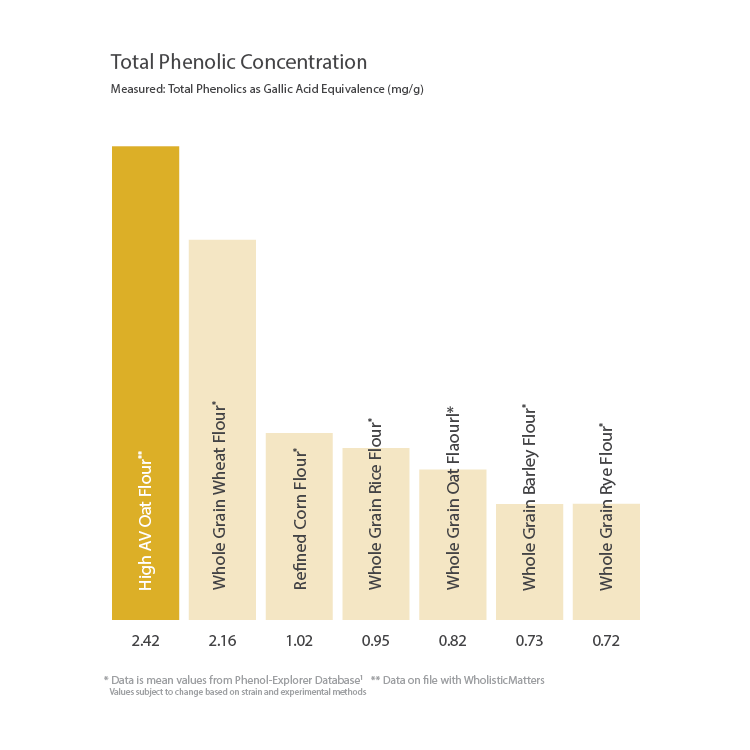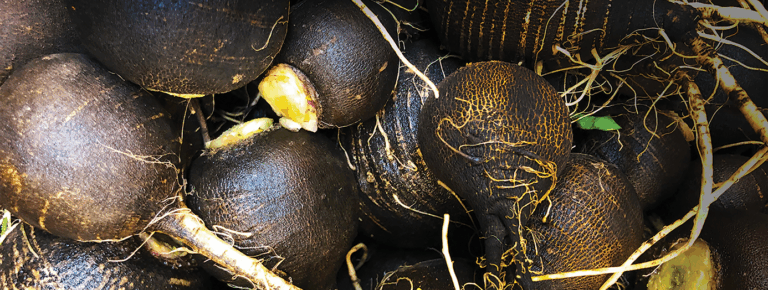Oats: Whole Food Profile
Oats (Avena sativa) are a widely consumed grain product as a rolled whole oat or ground into flour. They deliver a healthy source of energy paired with phenolic compounds, essential nutrients, soluble and insoluble fibers. Intake of soluble fibers from grain oats has been linked to reduced risk of cardiovascular disease (CVD). Top oat varieties include increased levels of phytochemicals and provide beneficial fibers.
Key Nutrients in Oats
Percentages shown as %DV per serving of 30g oats.

Total Phenolic Concentration in Oats
Measured: Total Phenolics as Gallic Acid Equivalence (mg/g).

Phytoactives in Oats
Fiber
Supports cardiovascular health, healthy bowel function, and healthy cholesterol levels
Beta-glucan (56 mcg/g)** The main soluble fiber in oats connected to reduced CVD risk- Arabinoxylan
- Type 1 Resistant Starch
Avenanthramides
Phenolic acids exclusive to oats with antioxidant and anti-inflammatory activities and a bitter perception
- Avenanthramide C (49.24 mcg/g)*
- Avenanthramide B (31.85 mcg/g)*
- Avenanthramide A (31.67 mcg/g)*
- Avenanthramide E (0.15 mcg/g)*
Lignans
Large plant polyphenolic compounds that bypass human digestion, feed gut bacteria, and provide antioxidant activity
- Syringaresinol (3.5 mcg/100g)*
- Lariciresinol (1.8 mcg/100g)* Matairesinol (0.7 mcg/100g)*Medioresinol (0.4 mcg/100g)*
- Secoisolariciresinol (0.1 mcg/100g)*
- Pinoresinol (0.08 mcg/100g)*
Phenolic Acids
Compounds that promote antioxidant activity and vascular health
- 4-Hydrobenzoic Acid (4.5 mcg/g)*
- Vanillic Acid (2.7 mcg/100g)*
- Ferulic Acid (1.9 mcg/100g)*
- p-Coumaric Acid (1.6 mcg/100g)* Hydrobenzaldehyde (1.2 mcg/100g)*
- Sinapic Acid (0.4 mcg/100g)*
Flavanones
Colorless flavonoid compounds with antioxidant activity
- Neohesperidin (6.2 mcg/g)*
Saponins
Support the immune system, healthy cholesterol levels, and blood glucose levels
- Avenacoside A
- Avenacoside B
*Data is mean values from Phenol-Explorer Database1
**Data on file with WholisticMatters. Values subject to change based on strain and experimental methods
Did you know WholisticMatters is powered by Standard Process? Learn more about Standard Process’ whole food-based nutrition philosophy.
Gunther-Jordanland K., Dawid, C., Dietz, M., & Hofmann, T. (2016) Key Phytochemicals Contributing to the Bitter Off-Taste of Oat (Avena Sativa L.). Journal of Agricultural and Food Chemistry, 64(51), 9639-9652. Doi:10.1021/acd.jafc.6b04995
Morales-Polanco, E., Campos-Vega, R., Gaytan-Martinez, M., Enriquez, L. G., & Loarca-Pina, G. (2017). Functional and textural properties of a duhulled oat (Avena Sativa L.) and pea (Pisum sativum) protein isolate cracker. LWT, 86, 418-423. Doi:https://doil.org/10.1016/j.lwt.2017.08.015.
Rothwell, J.A., et al., Phenol-Explorer 3.0: a major update of the Phenol-Explorer database to incorporate data on the effects of food processing on polyphenol content. Database, 2013. 2013: p. bat070-bat070.
Tian, L., H. Gruppen, and H.A. Schols, Characterization of (Glucurono) arabinoxylans from oat using enzymatic fingerprinting. Vol. 63. 2015.




